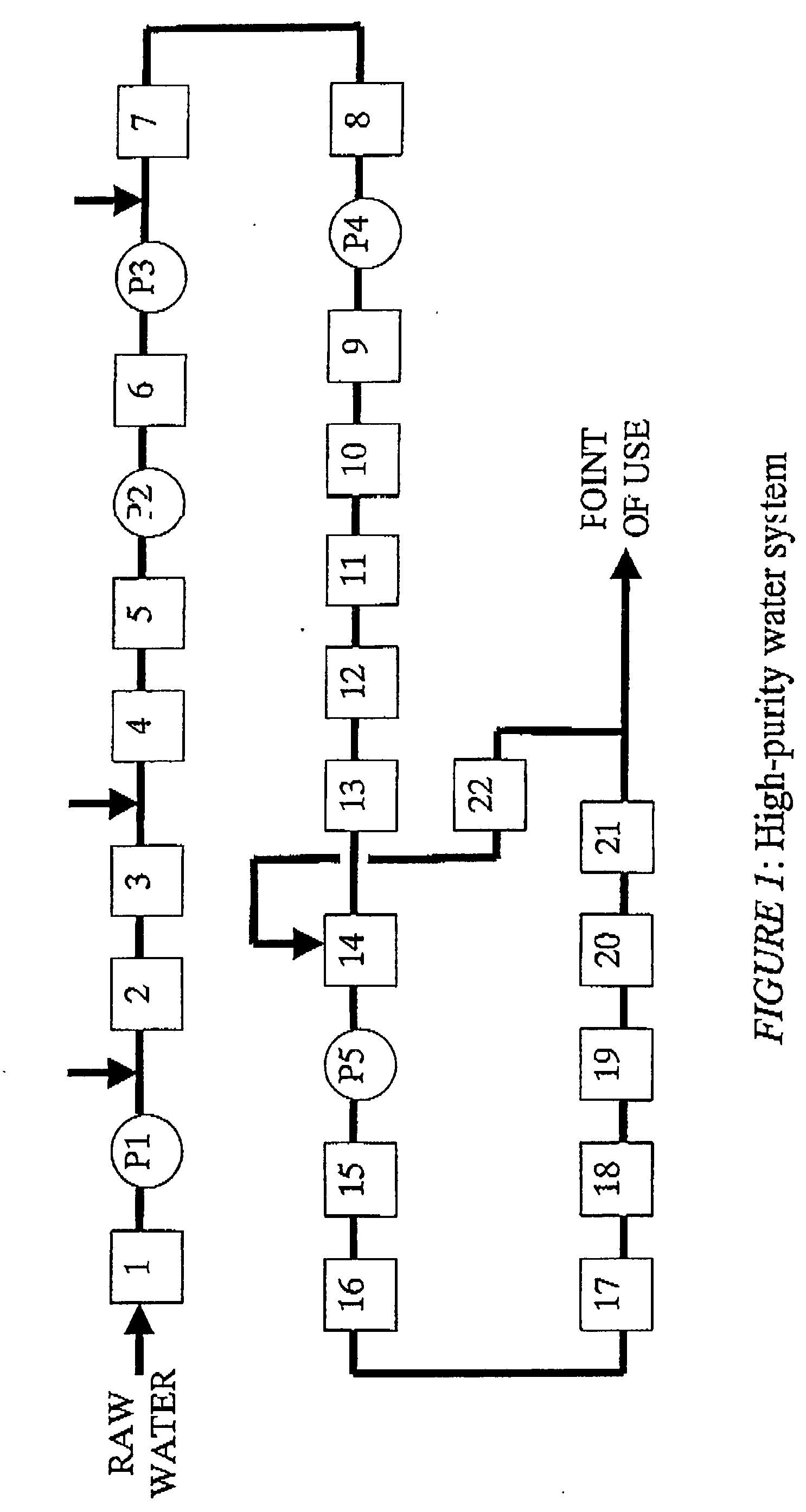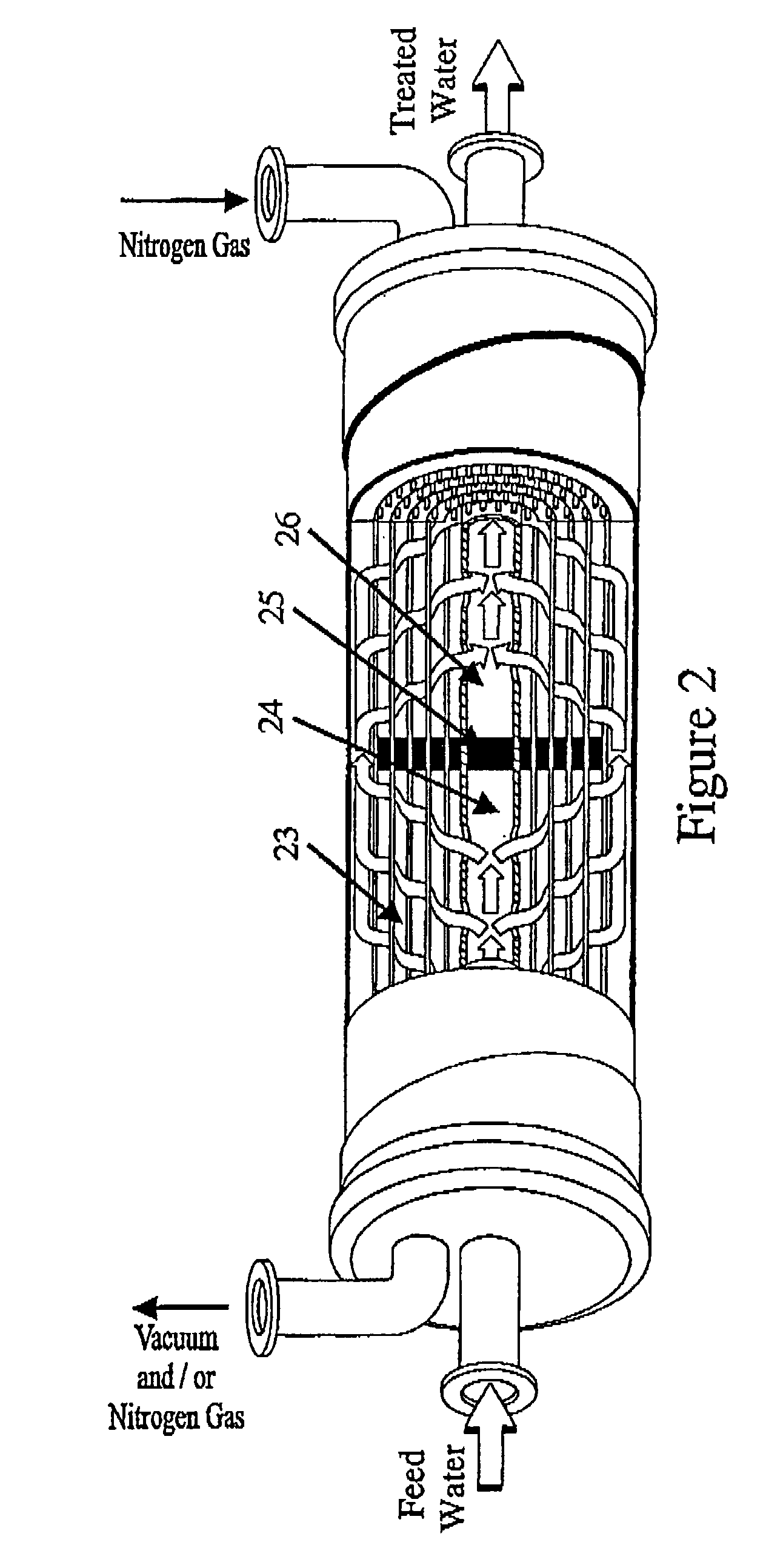Method of removing organic impurities from water
a technology of organic impurities and water, applied in the field of organic impurities removal methods, can solve the problems of complex and expensive hardware required for carrying out high-purity water processing procedures, unable to modify chloroform to yield an ionic entity capable of ion exchange removal, and unable to tolerate such impurities. to achieve the effect of reducing flux rates, reducing temperature, and reducing flux rates
- Summary
- Abstract
- Description
- Claims
- Application Information
AI Technical Summary
Benefits of technology
Problems solved by technology
Method used
Image
Examples
example 1
[0101] A test was conducted at the pilot test equipment described above according to the invention at a deionised water feed flow rate of 7 gpm. The applied vacuum level was kept constant at -700 mm Hg. The result of analysis for the deionised water so treated is listed in the following Table 4.
4TABLE 4 Performance of two 4-inch contactors in series at 7-gpm flow Temperature, Parameters .degree. C. Feed Water Treated Water % Removal Chloroform, 25.0 16.9 7.5 55.6 ppb 35.0 15.7 6.3 59.9 45.0 14.0 2.5 82.1 TOC, ppb 25.0 11.3 4.9 56.6 35.0 16.8 6.6 60.7 45.0 13.7 2.9 78.8 Dissolved 25.0 2730 2.0 99.93 oxygen, 35.0 3010 0.6 99.98 ppb 45.0 3280 0.4 99.99
example 2
[0102] A test was conducted at the pilot test equipment described above according to the invention at a deionised water feed flow rate of 10 gpm. The applied vacuum level was kept constant at -700 mm Hg. The result of analysis for the deionised water so treated is listed in the following Table 5.
5TABLE 5 Performance of two 4-inch contactors in series at 10-gpm flow Temperature, Parameters .degree. C. Feed Water Treated Water % Removal Chloroform, 25.0 15.2 8.2 46.0 ppb 35.0 14.8 7.4 50.0 45.0 16.6 5.5 66.9 TOC, ppb 25.0 14.3 7.9 44.8 35.0 17.8 9.1 48.9 45.0 11.5 3.9 66.1 Dissolved 25.0 2590 6.1 99.76 oxygen, 35.0 2910 2.0 99.93 ppb 45.0 2740 0.9 99.97
example 3
[0103] A test was conducted at the pilot test equipment described above according to the invention at a deionised water feed flow rate of 14 gpm. The applied vacuum level was kept constant at 650 mm Hg. The result of analysis for the deionised water so treated is listed in the following Table 6.
6TABLE 6 Performance of two 4-inch contactors in series at 14-gpm flow Temperature, Parameters .degree. C. Feed Water Treated Water % Removal Chloroform, 25.0 14.1 10.9 22.7 ppb 35.0 15.4 11.7 24.6 45.0 14.6 9.9 32.2 TOC, ppb 25.0 12.4 9.7 21.8 35.0 16.1 12.4 22.9 45.0 10.2 7.3 28.4 Dissolved 25.0 2810 26.1 99.07 oxygen, 35.0 2620 8.9 99.66 ppb 45.0 3340 6.1 99.82
PUM
| Property | Measurement | Unit |
|---|---|---|
| Fraction | aaaaa | aaaaa |
| Fraction | aaaaa | aaaaa |
| Fraction | aaaaa | aaaaa |
Abstract
Description
Claims
Application Information
 Login to View More
Login to View More - R&D
- Intellectual Property
- Life Sciences
- Materials
- Tech Scout
- Unparalleled Data Quality
- Higher Quality Content
- 60% Fewer Hallucinations
Browse by: Latest US Patents, China's latest patents, Technical Efficacy Thesaurus, Application Domain, Technology Topic, Popular Technical Reports.
© 2025 PatSnap. All rights reserved.Legal|Privacy policy|Modern Slavery Act Transparency Statement|Sitemap|About US| Contact US: help@patsnap.com



